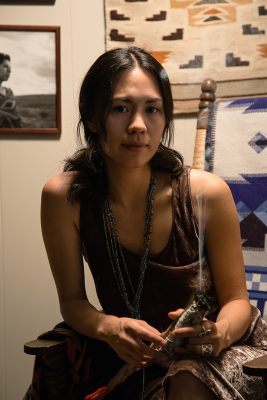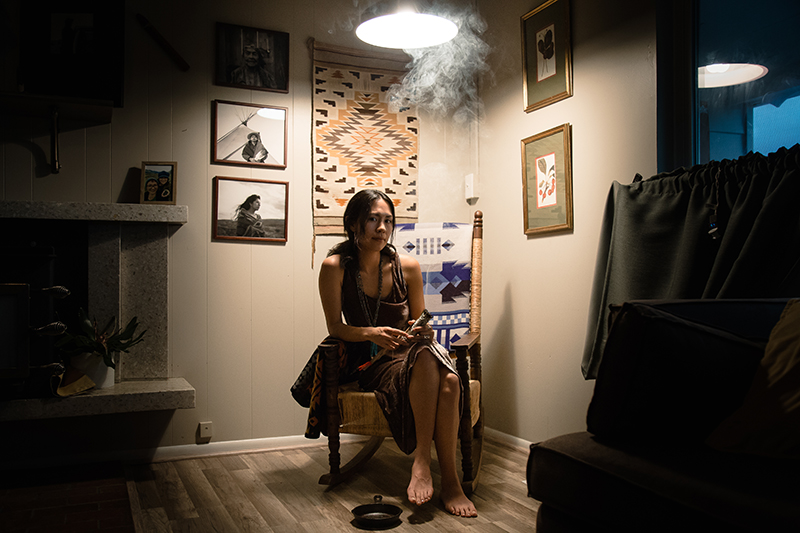Capturing Home, Visibility and Stillness: Denae Shanidiin and Indigenous Images
Art

Local photographer Denae Shanidiin is truly the embodiment of a multicultural artist. Working in images, ceramics, fashion and activism, Shanidiin expresses her complex Indigenous and Korean identity as it intersects with her place in the story of women and Native invisibility. Focusing on missing and murdered Indigenous people, as well as the beauty of labor and community, Shanidiin’s images speak quiet yet soaring truths of pain, love and belonging.
“Making images is my way of integrating myself into a nation, community, clan and sense of self I belong to but haven’t always nourished,” Shanidiin says. “My practice began when my first love gave me a camera to take home with me to the rez. My first roll of film was really beautiful … to me. I went to college for it, practiced hard and played hard with my dear friends, and was taught by some pretty rad professors. I’ve valued the nude, the intimate, the sacred, the personal, the ugly and the land.”
Shanidiin’s images often center around the simple yet sacred human moments in Indigenous experience, including the most painful and raw realities of violence, colonization and disappearance that sit at the core of that experience. Her works are also imbued with a love and affection for lived experience that shine through and show her heart. Shanidiin reflects on her most meaningful images in her recollection: “the documentation of my older sister growing and giving life, photographs of my grandparents doing anything, because anything they do is beautiful to me, photographs of my first boyfriend that remind me of a really blissful and sweet time in my life. The work is directly linked to my self-esteem, self-significance. I need to create beauty to feel mentally healthy and elated.”
“The images reflect a space sacred enough to call home.”

Her more recent works over the past year have centered around the missing and murdered, an artistic and activist mission that has come with costs as well as growth.
Shanidiin relates the litany of effects this work has had on her personally this year, “A lot of anger, tears, heartache, homesickness, fire and being painfully humbled by the strength of this human condition,” she says. “I was gifted a lot of medicine and protection during this time while I was observing a lot of chaos (children of dead mothers, aunties and mothers with broken hearts, and the decline of health to follow after this kind of pain, [which] I have found to be in abundance). The medicine helped with this exposure … medicine being blessings, prayer paraphernalia, companionship and love.
“I feel strong and I’ve grown so much. I’m grateful to know these truths and to address them in ways that I am capable of.”
Alongside her missing and murdered project, Shandiin balances photographic tales of everyday Indigenous life, including human interactions rooted in simplicity. “I find myself gravitating towards the beauty of labor and, in that,” she says, “finding symbolism, memory, strength, and resilience in the many ways of life we live as Indigenous people.” Her Labor and Beauty Series | Alkaan, Sacred Diné Corn Cake 2018 tells of the crafting of a consecrated, shared experience. “The images reflect a space sacred enough to call home, a place where generations of women are congregated in prayer for intentional purpose, to ensure that our young girls are blessed in the ways that define us as Diné women. It’s a beautiful way to love our people, our mother earth and our ancestors.”
“I like to stay grounded within myself and not find myself in any scene.”

Shanidiin’s awareness of community and collaboration are suffused within her artistic career, as she honors both her Indigenous artist colleagues and her ancestry.
“I have many artists in my bloodline,” she says. “I know it to be part of my spirit. I also live in a home with many creators. Shi’ma, my mother, and my sisters are all artists, and we dream a lot together … create in different ways, and often, we make things to adorn our limbs, fingers and ears. My very dear friend Alexis Munoa (also a photographer) … her images and concepts around beauty and home, language and land is very often the topic of conversation between us two. Her love for creation and healing through her practice is incredibly beautiful and influential to me. My favorite Diné artist is Jeff Slim—a painter whose work involves a lot of colors—which is somehow not overwhelming for me but rather fascinating. I love the way he paints figures and hands, and his concepts are spiritually intelligent.”
Shanidiin’s respect for fellow Indigenous artists seems to highlight her own work further, and she finds herself seeking authenticity and an accessible, unglamorous approach to her place in the world of contemporary photography. “I like to stay grounded within myself and not find myself in any scene, but rather do work that feels true and good for me and that feels like home,” she says “I’m learning how to be more intentional in my taste and with the tools that inform images I seek to create.”
“I see my work finding a relationship closer to home, where my grandparents live. I hope to confront racism, honor Indigeneity and explore beauty with my viewers.”

It seems fitting that Shandiin seeks to cultivate a sense of safety and sanctuary in her work, two deeply vital and inviolable human needs of which her Indigenous culture has been divested. Her imagery and the way she integrates fully into it makes for herself and her subjects something of a home. “It’s a really nice way for me to honor what I value,” says Shanidiin. “It makes me love my world more, appreciate my relations more fully, and it helps me process pain and my story. In that experience, I find growth, and to me, that’s refuge … always growing. The experience of growth is realized in the moments of stillness and processing.”
Shandiin envisions her future work coming ever further back to her sanctuaries: “I see my work finding a relationship closer to home, where my grandparents live. I hope to confront racism, honor Indigeneity and explore beauty with my viewers. It’s kind of where I’m at personally … my sense of self as an artist isn’t linked to this idea of seeking glamour and any public reaction. This past year has been taxing for me, doing missing and murdered work, and my spirit has been all over the place. So in that experience, I’ve been digesting the idea of returning home. My home is where my grandparents are, a place I will return to, a place of refuge, a quiet and humble space for me to be, where I often experience the most loving and profound moments, among my kin in their sacred years of old age.”
Shanidiin’s images can be found on Instagram @denaeshanidiin, and her missing and murdered project at @mmiwhoismissing.
More on SLUGMag.com:
SLUG Style: Denae Shanidiin
Invisible Eulogy: Gregg Deal Brings Native Visibility to the Transcontinental Exhibit

